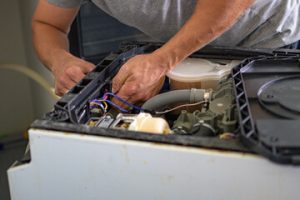
Refinishing cabinets is an affordable way to give your kitchen a facelift. But it’s important to do the job right to avoid regrets later.
Unforeseen problems can arise from everything from using the wrong cleaner to skipping key prep steps. Learn about the most common mistakes to avoid when refinishing cabinets so your project is successful. Visit San Jose Cabinet Refinishing for more information.
1. Not Prepping the Cabinets Properly
Cabinets are exposed to a lot of wear and tear, grease, and moisture. This can cause them to warp, swell, or even start to mold or mildew. If this happens, it can be difficult to repair and often results in peeling paint. Proper painting preparation is essential to help prevent this and ensure your new finish lasts for as long as possible.
To prepare your cabinets for a new finish, you need to clean and sand them. This process will remove any dirt, grease, and other debris that could affect paint adhesion and appearance. Using a sanding sponge or random orbital sander with 150 or 180 grit sandpaper will give your surfaces the “tooth” they need to accept and adhere to the primer and topcoat. After sanding, vacuum and tack rag the surfaces to remove any remaining dust and residue.
After sanding, you can apply the first coat of primer to your cabinets. Allow the primer to dry completely before moving on to the next step. Once the primer is fully dry, lightly scuff sand the surfaces once again to promote topcoat adhesion and remove any minor imperfections. Vacuum and tack rag the surfaces again to make sure they are dust-free.
Once the surfaces are ready to be painted, apply your chosen color of choice. Be sure to follow the manufacturer’s instructions for applying your new finish. If you’re not experienced with this, it’s best to hire a professional interior painter in San Francisco to avoid any potential problems with your new finish.
2. Skipping the Sanding
While it may be tempting to skip the sanding step, it’s important to properly prepare the cabinets for paint. Lightly sanding the surfaces with fine-grit sandpaper will roughen up the existing finish and improve the primer and paint’s adhesion. After sanding, be sure to wipe down the cabinetry to remove any dust particles. It’s also a good idea to use low-VOC primer and paint.
Another common mistake is skipping the second or final coat of paint. A second or final coat of paint helps to seal the surface, preventing moisture from seeping through. It also prevents the new color from fading or peeling over time. When painting over dark wood or making a drastic color change, it’s important to use a stain-blocking primer like advance from Benjamin Moore or pro classic from Sherwin Williams.
Avoiding these common mistakes can help your painted cabinets last for years. It’s also important to keep a small amount of leftover paint on hand for touch-ups as needed. Regular touch-ups can help prevent serious damage, especially if the cabinets are exposed to constant moisture exposure such as steam and water.
If your cabinets are showing signs of deterioration, it’s important to contact an expert for a professional refinishing job. Damage such as cracking, chipping, or warping is beyond the scope of most DIY projects and requires expert attention. A professional refinishing can also save you money in the long run, as it will increase the longevity of your cabinetry and improve its appearance and functionality. Proper cleaning techniques, avoiding moisture exposure, handling cabinetry gently and addressing minor chips promptly will also prolong the life of your cabinetry. A professional refinishing project is often the best option when you want your painted cabinets to look their very best for years to come.
3. Using the Wrong Paint
If you’re looking to make a big change in your kitchen without spending the money on a major remodel, repainting cabinets is an affordable option. However, this project requires a lot of hard work and patience to ensure the best results. To get the look you want, avoid these common mistakes that can derail your cabinet refinishing project.
Using the Wrong Paint
It’s tempting to skip the primer and jump right to the paint, but this can be a recipe for disaster. Primer is important because it creates a smooth surface for the paint to adhere to, and helps hide any imperfections or discoloration on the wood. Skipping this step can result in uneven or patchy finishes that won’t hold up to the wear and tear of a busy kitchen.
Also, be sure to use a cabinet-rated paint rather than an all-purpose paint. This type of paint is thicker and designed to stand up to moisture and heavy use. The wrong kind of paint can crack, peel or yellow over time, causing your new finish to look old and worn before its time.
Another mistake that can be made is using the wrong paint sheen for cabinets. Matte paint may look modern, but it’s not durable for a high-traffic area like the kitchen and can collect smudges and grease marks quickly. Opt for a satin or semi-gloss finish instead.
Not Sealing
It’s tempting to add a coat of polyAcrylic or furniture wax on your newly painted cabinets, but this isn’t necessary. This is especially true if you’re using a high-quality, water-based polyurethane that doesn’t require sanding between coats.
4. Using the Wrong Primer
Many DIY’ers skip the primer when painting cabinets, and this is a mistake. Primer does more than just hide the previous paint color, it creates an ideal surface for the new coat of paint to adhere to. Without primer, the new paint will often peel or bubble due to poor adhesion.
Another mistake people make is using a water-based primer instead of an oil-based primer. Oil-based primers provide the best stain blocking and adhesion, but they can be stinky and require special clean up solutions. Water-based primers provide a similar seal and adhesion as oil-based primers, but they are much less toxic and easier to clean up. If you’re painting over existing painted cabinets, an oil-based primer is the way to go.
Finally, many DIY’ers use a tinted poly or wax to change the color of their cabinets. This is a quick and cheap way to change the look of your kitchen, but it’s not as durable as a good quality paint. It may also be difficult to re-apply the clear poly or wax once the cabinet paint is dry, and it may wash off with common household cleaners.
One final mistake that people make when painting their cabinets is not allowing the cabinet paint to fully cure before starting to use them. This is a big mistake because the cabinets can be damaged by water, grease or other substances while they are still wet. When refinishing your cabinets, always allow the paint to fully cure before you start using them. This may take up to 14 days, but it will ensure that your newly refinished cabinets look professional and last long. This is why it’s important to follow the manufacturer’s recommended dry/cure times when refinishing your cabinets.
5. Using the Wrong Paint Sheen
Those who cut corners on cabinet refacing often skip the most important step: preparing the cabinets. Cutting costs in this area can yield a project that looks great on the surface but is easily damaged by steam, condensation and grease. The result is peeling, mildew and mold — not exactly the best look for your kitchen!
Another common mistake when refinishing cabinets is applying too many thick coats of paint. Applying multiple thin layers allows the paint to dry more slowly and creates a finish that’s less likely to chip. It also gives the cabinets a more durable coating that can stand up to daily use and cleaning products.
Finally, a common mistake is using cheap or low-quality materials when refinishing cabinets. This can lead to a poor bond between the wood and the new finish, as well as a lack of durability. Stick with a high-quality product that’s designed for cabinet surfaces and follow the manufacturer’s recommended application and drying times to avoid these problems.
One last thing to keep in mind is the importance of priming. Many people skip this step and go straight to painting, but this is a big mistake. Cabinets need a rough surface to grip onto, so lightly sanding them will provide a good base for primer and paint. It’s also a good idea to clean with a degreaser before priming to ensure everything adheres properly.
Keeping your cabinets in top condition is easy with the right care and maintenance. By avoiding these mistakes and ensuring that your cabinets are properly prepared and sealed, you can enjoy them for years to come. If your cabinets are showing signs of wear, talk to an experienced refinisher today to discuss repair and restoration options.


